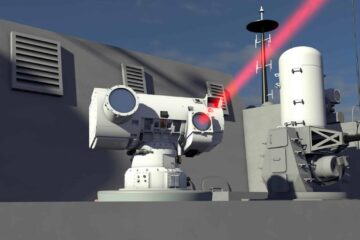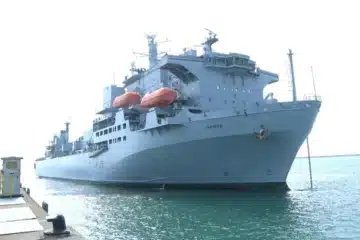Royal Navy press release
Flotillas of sail drones could serve as the ‘eyes and ears’ for larger warships, moving around the Gulf gathering intelligence, beaming it back in real time to ships and headquarters ashore.
Two exercises were run – the first involving British and American ships and personnel, the second also involving the navies of Bahrain and Saudi Arabia to see how the drones might be exploited by a multi-national task group.
For the latter, seven ships – RFA Cardigan Bay, minehunter HMS Bangor, two US Navy fast patrol ships USS Hurricane and Chinook, Bahrani missile boats Al-Manama and Al-Fateh, and Saudi patrol vessel HMS Khalid – headed for waters off the Saudi coast.

There the US operated sail drones were launched from Cardigan Bay, which also served as the command ship for Bahrain-led Combined Task Force 152, one of four task forces organized under the Combined Maritime Forces. The naval drill enhanced interoperability in integrating new uncrewed technologies to monitor the sea lanes in the Arabian Gulf.
The drones, which resemble sailboards but are packed with sensors, do just that. Powered by the wind and the sun, they can remain at sea indefinitely – no need to refuel or refresh crew.
The RN initially worked with the sail drones back in March as part of a larger multi-national exercise, but the two autumn trials focused more on integrating the crewless and artificial intelligence systems with traditional warships, as well as staffs ashore in Bahrain.
Sensors on the robot craft were able to locate and identify training aides in the water and send imagery back to the operations rooms and headquarters with a view to using such crewless vessels in future to monitor regional waters.

Royal Navy officer Lieutenant Benjamin Carver has been working with the US task group, CTF 59, formed specially to push the boundaries of tech in support of naval operations in the Gulf and relished the opportunity to take part in a live, large-scale, multi-national exercise to test the latest kit.
“I think autonomous systems are about to become a major aspect of the maritime world and it is really interesting to be here as they first hit the water. For this exercise we used some long-duration, wind-powered units that we deployed from crewed RN ships, and used them to feed back their imagery and data to ships around them and to control centres ashore, to build everyone’s awareness of what’s going on and what’s out there in these large tracts of sea.”
Royal Navy officer Lieutenant Benjamin Carver
Lt Carver and his US colleagues believe they are in the vanguard of future naval operations. “Working with autonomous technology feels like the early days of naval aviation, we don’t know exactly what it’s going to look like, but we know it’s going to be huge.”
Certainly Captain Rashed Al-Ameen, commander of CTF 152, was impressed by the insight into the potential of crewless technology to support regular operations in the region.
“It is so valuable to get these opportunities to really test how our forces from across different nations can work together with the uncrewed systems. It helps us better understand how to work with each other to boost regional security.”






